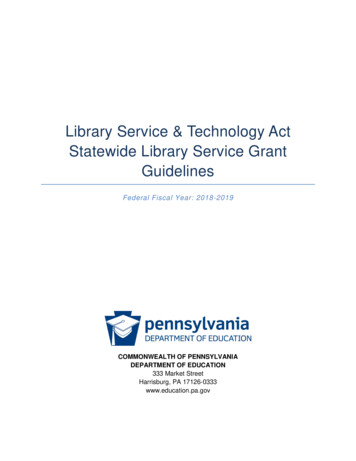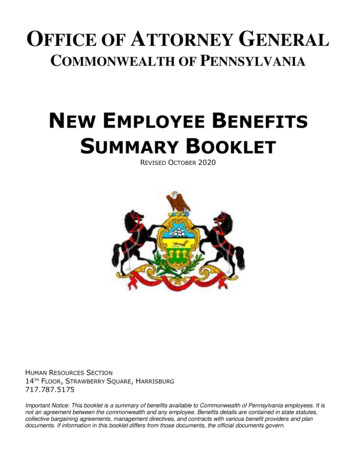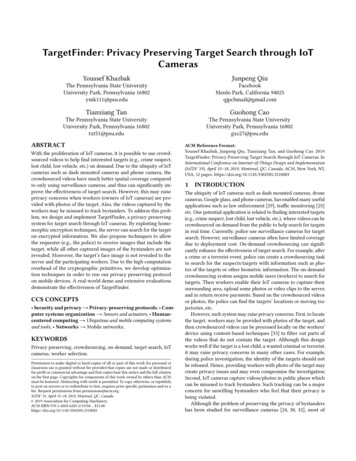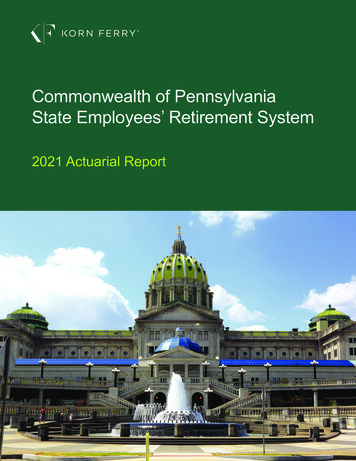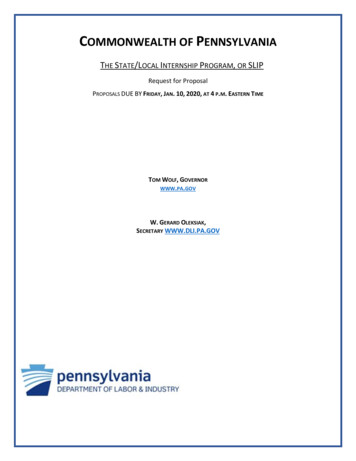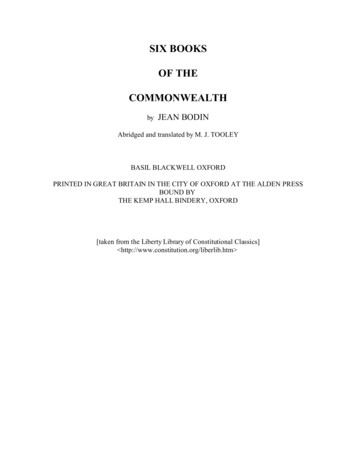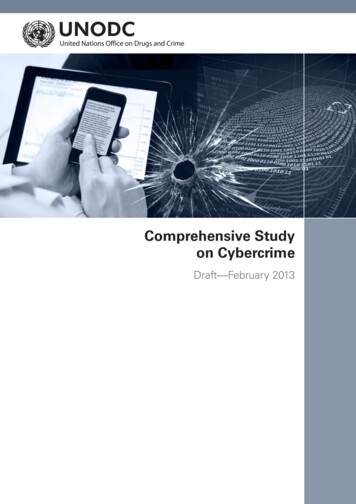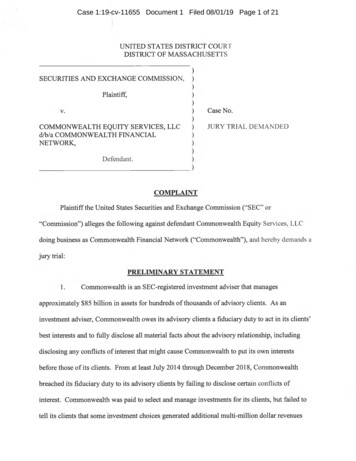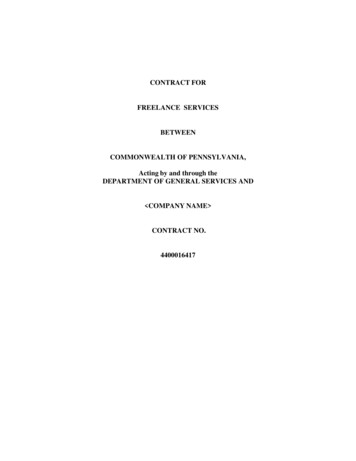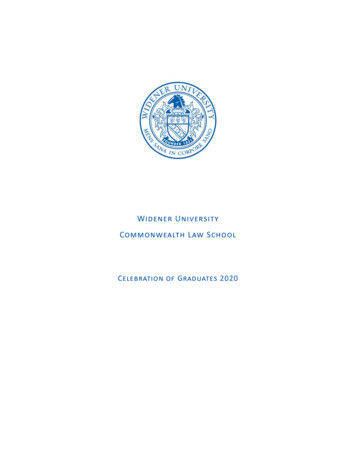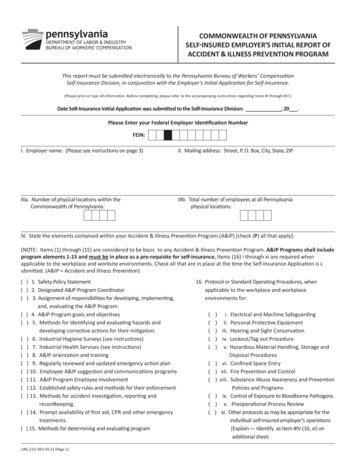
Transcription
COMMONWEALTH OF PENNSYLVANIASELF-INSURED EMPLOYER’S INITIAL REPORT OFACCIDENT & ILLNESS PREVENTION PROGRAMDEPARTMENT OF LABOR & INDUSTRYBUREAU OF WORKERS’ COMPENSATIONThis report must be submitted electronically to the Pennsylvania Bureau of Workers’ CompensationSelf-Insurance Division, in conjunction with the Employer’s Initial Application for Self-Insurance.(Please print or type all information. Before completing, please refer to the accompanying instructions regarding Items #I through #VI.)Date Self-Insurance Initial Application was submitted to the Self-Insurance Division: , 20 .Please Enter your Federal Employer Identification NumberFEIN:I. Employer name: (Please see instructions on page 3)II. Mailing address: Street, P. O. Box, City, State, ZIPIIIa. Number of physical locations within theCommonwealth of Pennsylvania:IIIb. Total number of employees at all Pennsylvaniaphysical locations:IV. State the elements contained within your Accident & Illness Prevention Program (A&IP) [check (P) all that apply]:(NOTE: Items (1) through (15) are considered to be basic to any Accident & Illness Prevention Program. A&IP Programs shall includeprogram elements 1-15 and must be in place as a pre-requisite for self-insurance. Items (16) i through xi are required whenapplicable to the workplace and worksite environments. Check all that are in place at the time the Self-Insurance Application is submitted. (A&IP Accident and Illness Prevention)( ) 1. Safety Policy Statement( ) 2. Designated A&IP Program Coordinator( ) 3. Assignment of responsibilities for developing, implementing,and, evaluating the A&IP Program.( ) 4. A&IP Program goals and objectives( ) 5. Methods for identifying and evaluating hazards anddeveloping corrective actions for their mitigation.( ) 6. Industrial Hygiene Surveys (see instructions)( ) 7. Industrial Health Services (see instructions)( ) 8. A&IP orientation and training( ) 9. Regularly reviewed and updated emergency action plan( ) 10. Employee A&IP suggestion and communications programs( ) 11. A&IP Program Employee Involvement( ) 12. Established safety rules and methods for their enforcement( ) 13. Methods for accident investigation, reporting andrecordkeeping.( ) 14. Prompt availability of first aid, CPR and other emergencytreatments.( ) 15. Methods for determining and evaluating programLIBC-221I REV 10-21 (Page 1)16. Protocol or Standard Operating Procedures, whenapplicable to the workplace and workplaceenvironments for:((((((((((() i. Electrical and Machine Safeguarding) ii. Personal Protective Equipment) iii. Hearing and Sight Conservation) iv. Lockout/Tag out Procedure) v. Hazardous Material Handling, Storage andDisposal Procedures) vi. Confined Space Entry) vii. Fire Prevention and Control) viii. Substance Abuse Awareness and PreventionPolicies and Programs) ix. Control of Exposure to Bloodborne Pathogens) x. Preoperational Process Review) xi. Other protocols as may be appropriate for theindividual self-insured employer’s operations[Explain — Identify as Item #IV (16, xi) onadditional sheet.
V. Number of [Explain — Identify as Item #IV (16, xi) on Accident & Illness Prevention Personnel involved with the Program:(See Instructions)a. Staff Personnelb. Contracted Personnelc. In-Service Statusd. Request for In-Service Status (Complete page 3)VI. Which of the following method(s) are to be used to determine the effectiveness of the Accident & Illness PreventionProgram [check (P) method(s) to be used]:For the method(s) indicated, (if available) please supply the requested information.i.( )OSHA/BLS Incidence Rate Comparison by the North American Industry Classification (NAICS) numberPlease State Incidence Rate:a. Prior fiscal yearb. One year prior to last fiscal yearc. Two years prior to last fiscal yearii.( )Comparison of Statistics Derived from “First Reports”Please State your Injury and Illness Rate Using the FORMULA in the Instructions:a. Prior fiscal yearb. One year prior to last fiscal yearc. Two years prior to last fiscal year( )iii.Experience Modification Factor or Loss RatioE-MOD FACTORLOSS RATIOa. Prior fiscal yearb. One year prior to last fiscal yearc. Two years prior to last fiscal year( )iv.Other [any other methods used by the organization to determine the effectiveness of the Accident &Illness Prevention Program]I, the undersigned, verify that the facts set forth in this report and any attachments are true and correct. This verification is made subject tothe penalties of Section 4904 of the Crimes Code, 18 Pa.C.S. §4904, relating to unsworn falsification to authorities.Name/contact (typed/printed)TitleEmail addressTelephoneSignatureDatePennsylvania Bureau of Workers’ CompensationHealth and Safety DivisionReport Processing & Audit Section1171 South Cameron Street, Room 324Harrisburg, PA 17104-2501LIBC-221I REV 10-21 (Page 2)Auxiliary aids and services are available upon request to individuals with disabilities.Equal Opportunity Employer/Program*221I*
REQUEST FOR INDIVIDUAL SERVICE PROVIDER IN-SERVICE STATUS(Please print or type the following information for all employees and/or contracted personnel that you are requesting In-Service forwho do not possess a current approved designation and that have not previously been granted “In-Service” status).(Mr., Mrs., Ms.)First NameIs service provider an employee?M.I.Last Nameor contracted?What is the date the above service provider began providing Accident & Illness Prevention Services?MMDDYYYYAccident & Illness Prevention Service provider(s) information with regard to In-Service status:Name of recognized provider directing the above-mentioned in-service provider:(Mr., Mrs., Ms.)First NameM.I.Last NameRecognized Provider designationCredential CodeExperience Provider #ELIBC-221I REV 10-21 (Page 3)EmployeeContracted
Instructions for Completing Form LIBC-221ISELF-INSURED EMPLOYER’S INITIAL REPORT OF ACCIDENT & ILLNESS PREVENTION PROGRAMThis Self-Insured Employer’s Initial Report of Accident & Illness Prevention Program Form must be submitted electronically with thePennsylvania Department of Labor & Industry, Bureau of Workers’ Compensation, Application for Self-Insurance Status.As part of its application for individual self-insurance status submitted to the bureau, an applicant for individual self-insurance statusshall provide the bureau with detailed information on its accident and illness prevention program.As part of the process of granting individual self-insurance status, the bureau will use this information to determine whether to grantindividual self-insurance status.NOTE: The term Accident & Illness Prevention Services as described in the Pennsylvania Workers’ Compensation Act issynonymous with the terms Safety and Health Program, and Loss Control Program.FEIN: (Federal Employer Identification Number)Enter the Federal Employers Identification Number (FEIN) assigned to your organization.ITEM I:Enter the full name of the self-insured employer as it will be submitted with the request for self-insurance status.ITEM II:Enter the address of the self-insured employer as it will be submitted with the request for self-insurance status.ITEM IIIa:Enter the total number of locations, where employees are present on a daily basis, that are to operate by the self-insuredemployer within the Commonwealth of Pennsylvania.ITEM IIIb:Enter the total number of employees at all locations reported in IIIa.ITEM IV:Check (P) the elements contained within the Accident & Illness Prevention Program developed, implemented and monitoredby the Self-Insured Employer. Elements V (1) through (15) are mandatory by the Pennsylvania Workers’ Compensation Act;while the protocols or standard operating procedures listed under 16 are applicable to the workplace and worksiteenvironment.The following definitions apply to the Accident & Illness Prevention Program Elements 1 through 15:(1)Safety Policy Statement: A written statement regarding the Accident & Illness Prevention Policy that containsthe self-insured employer’s philosophy regarding accident and illness prevention. The safety program policystatement serves as the foundation for all program activities. The statement should be signed by a chiefexecutive officer and is communicated to all employees.(2)Designated A&IP Program Coordinator: An individual(s) appointed by the employer to coordinate theprovision of the Accident & Illness Prevention Program, by location or on a companywide basis. Assignment ofthe Safety Program Coordinator must be documented and made part of the designated individual’s duties andresponsibilities.(3)Assignment of responsibilities for developing, implementing and evaluating the A&IP Program: Assignment ofAccident & Illness Prevention Program responsibilities, as they pertain to employees and staff, (includescontracted providers retained and responsible for certain program elements). The individual, position and/ortitle of the position, and the assignment of individual or position responsibilities must be documented.(4)Program Goals and Objectives: A documented procedure explaining how Accident & Illness PreventionProgram goal(s) and objective(s) are set. Example: a goal may be a 25% reduction in the number of recordableinjuries (OSHA definition) during a specific period; while an objective could be the improvement of safetyprocedures related to a task or operation.LIBC-221I REV 10-21 (Page 4)
ITEM IV: (Con’t.)(5) Methods for identifying and evaluating hazards and developing corrective actions for their mitigation: Writtenprocedures for identifying hazards, evaluating hazards, and developing corrective actions for their mitigation. Thepurpose is to eliminate or reduce occupational accidents, injuries and illnesses. Activities may include, but not belimited to: providing solutions, explanations, resources, reference materials and referrals.(6) Industrial Hygiene Surveys: Surveys required by the nature of the individual self-insured employer’s workplace andworksite environments. These surveys may include suspected chemical, physical or biological exposures, andproduce recommendations designed to control and/or prevent identified exposures.(7) Industrial Health Services: Written policy providing for industrial health services required by the nature of theindividual self-insured employer’s workplace environment. These services should address the physical, mental andsocial well being of employees in relation to their workplace environment. The results of these services mayproduce recommendations designed to identify, control and/or eliminate health hazards.(8) A&IP Orientation and Training: A&IP orientation and training for the purpose of enhancing employees’ knowledge,skills, attitudes and motivations concerning health and safety requirements relating to operations, processes andspecific work environments.(9) Regularly Reviewed and Updated Emergency Action Plan: A written plan designed to provide a quick andpre-planned response to emergency events that include, but are not limited to: fires, floods and/or gas leaks. Theplan must include procedures for employee safety and accountability during unexpected emergency conditions.(10) Employee A&IP Suggestion and Communication Programs: A documented procedure describing the processwhereby employees can offer suggestions and communicate their concerns related to employee A&IP.(11) A&IP Program Employee Involvement: Documentation of method(s) whereby employees have the opportunity toparticipate in Accident & Illness Prevention Program projects and activities, including assumption of certain programresponsibilities, either on an assigned or voluntary basis.(12) Established Safety Rules and Methods for their Enforcement: Written safety rules and enforcement procedures thatprovides for a safe workplace environment.(13) Methods for Accident Investigation, Reporting and Recordkeeping: A written procedure explaining and providingfor the timely investigation of accidents, completion of required reporting and recording, and recordkeeping.Information resulting from accident investigation, reporting and records may be used to prevent future employeerisk, exposure and accidents.(14) Availability of First Aid, CPR and Other Emergency Treatments: Documentation explaining how prompt availabilityof first aid, CPR and other emergency treatments are provided for injured or suddenly ill employees. Thesetreatments include on-site services, as well as those provided by the medical community.(15) Method(s) for Determining and Evaluating A&IP Program: Documentation of the method(s) used for assuring thequality of the Accident & Illness Prevention Program. Different than effectiveness measures, this element wouldinvolve actual review and critique of the program for the purpose of determining the strength(s) and weakness(es)of its components, as well as program areas that may require revision.(16) Work Environment Procedures Relating to:LIBC-221I REV 10-21 (Page 5)(i)Electrical and Machine Safeguarding: A procedure for the installation of systems, hardware and equipmentinstalled upon, around, over or near any machine or electrical installation to eliminate accidentalcontact by any person with the hazardous mechanical or electrical components for the purpose ofpreventing injuries.(ii)Personal Protective Equipment: A program that addresses the selection, purchase, training of employeesand enforcement of the use of devices and apparel determined necessary for employees to protect againsthazards in the work environment.
ITEM IV: (Con’t.)(iii)Hearing and sight conservation: Hearing conservation programs established to reduce, or eliminatewhere possible, the level of noise in the work environment to safe levels. Sight conservation programsestablished to safeguard the eyesight of employees in the work environment. Methods implemented inthese programs may include, but not be limited to the use of personal protective equipment (safetyglasses, goggles, face shields, personal hearing protection, etc.), point of operation equipment guards,non-hazardous tools, proper illumination, engineering controls and administrative controls.(iv)Lockout/tag out procedures: A procedure consisting of controls and employee training to ensure thatmachines, equipment, and/or piping are isolated, de-energized and completely inoperative (locked out)before servicing or maintenance is performed. This procedure shall also protect employees from theunexpected machine startup, release of unsafe liquid or gas or contact with electrical sources.(v)Hazardous material handling, storage, and disposal procedure: A procedure that identifies and controlsthe receipt, handling, storage and disposal of hazardous chemicals and products containing hazardouschemicals. Included is the development of a chemical inventory, procurement of material safety datasheets (MSDS), training for employees in identifying hazardous materials, understanding possibleexposures and routes of entry of the chemical into the body, knowledge of the signs and symptoms ofoverexposure, and recommended first-aid procedures.(vi)Confined space entry procedure: A procedure to follow when entering, for any reason, any area thathas limited openings for entry and exit that would make escape difficult in an emergency, has a lack ofventilation, contains known and potential hazards, and/or is not intended or designed for continuoushuman occupancy.(vii) Fire prevention and control practices: Documented practices for the prevention and control of fires andtheir related cause factors. These practices also include methods for responding to fires should theyoccur, employee evacuation procedures, and other applicable techniques for protecting life.(viii) Substance abuse awareness and prevention policies and programs: These policies and programs mustinclude the employer’s methods that are implemented to inform employees of the hazards associatedwith the use of, or being under the influence of alcohol or other controlled substances in the workplace.LIBC-221I REV 10-21 (Page 6)(ix)Control of exposure to bloodborne pathogens: A program providing for protecting employees against thehazards related to exposure to blood or other potentially infectious body fluids. This also includes employeetraining and a procedure for implementing an immediate response should an exposure incident occur.(x)Pre-operational process review: A procedure providing for the review of plans, drawings, diagrams andspecifications for processes, equipment and machinery prior to their use and introduction into the workplace.This review is for the purpose of identifying and correcting hazardous conditions.(xi)Other protocols: Determined to be necessary for the protection of employees from injury and illness while inthe employer’s employment based on the type(s) of operation(s), workplace and work environments.
ITEM V:Accident & Illness Prevention Service Provider QualificationsTo be qualified as an Accident & Illness Prevention Service Provider within the meaning of Section 1001 (a) and (b) of the Act(77 P.S. § 1038.1(a) and (b)) and this chapter, a person shall obtain one or more of the following qualifications and have two yearsof acceptable safety 17.18.19.Certification as a medical doctor (M.D.) in occupational medicine granted by the American Board of PreventiveMedicine (ABPM).Certification as an industrial hygienist (CIH) granted by the American Board of Industrial Hygiene (ABIH).Certification as a safety professional (CSP) granted by the Board of Certified Safety Professionals (BCSP).Certification as an industrial hygienist in training (IHIT) granted by the American Board of Industrial Hygiene (ABIH).Certification as an associate safety professional (ASP) granted by the Board of Certified Safety Professionals (BCSP).A bachelor’s degree, master’s degree or doctoral degree in safety earned from an accredited program from anaccredited college or university.A bachelor’s degree, master’s degree, or doctoral degree in science or engineering with a major concentration inoccupational/industrial safety and health from an accredited program within an accredited college or university.Certification as an occupational health nurse (COHN) granted by the American Board for OccupationalHealth Nurse (ABOHN).Certification as an Occupational Health & Safety Technologist (OHST) granted by the Board of Certified SafetyProfessionals (BCSP).An advanced safety certificate earned from the National Safety Council’s Safety Training Institute.An associate in loss control management (ALCM) earned from the Insurance Institute of America (IIA).An associate risk management (ARM) earned from the Insurance Institute of America (IIA).Certification as a safety executive (WSO-CSE), safety manager (WSO-CSM) or safety specialist (WSO-CSS)granted by the World Safety Organization (WSO).Certification as a professional ergonomist (CPE) granted by the Board of Certification of ProfessionalEgonomists (BCPE).Registered safety manager granted by the International Board of Environmental Health & Safety Inc. (IBOEHS).Certification with a Certified Risk Managers (CRM) designation granted by The National Alliance for InsuranceEducation & Research.Certified Safety and Health Managers (CSHM) granted by the Institute for Safety and Health Management.Certification as a Certified Instructional Trainer (CIT) granted by the Institute for Safety and Health Managementgranted by the Board of Certified Safety Professionals (BCSP).Certification as a Safety Trained Supervisor (STS) granted by the Board of Certified Safety Professionals (BCSP).INDUSTRY-SPECIFIC QUALIFICATIONS:20.21.22.23.24.25.26.27.Trucking: Certified Director of Safety (CDS) granted by the North American Transportation ManagementInstitute (NATMI).Trucking: Certified Safety Supervisor (CSS) granted by the North American Transportation ManagementInstitute (NATMI).Healthcare: Certified Healthcare Safety Professional (CHSP) granted by the International Board forCertification Services and Management (IBFCSM).Construction: Construction Health and Safety Technician (CHST) granted by the Board of CertifiedSafety Professionals (BCSP).Treecare: Certified Treecare Safety Professional (CTSP) granted by the Tree Care Industry Association, Inc.Construction: Safety Trained Supervisor Construction (STSC) granted by the Board of Certified SafetyProfessionals (BCSP).Hazardous Materials: Certified Hazardous Materials Manager (CHMM) granted by the Institute ofHazardous Materials Management (IHMM).Hazardous Materials: Certified Dangerous Goods Trainer (CDGT) granted by the Institute of HazardousMaterials Management (IHMM).Those who hold an industry specific qualification are only permitted to provide accident and illness prevention services within thedesignated industry.LIBC-221I REV 10-21 (Page 7)
In-Service Status: A person who is currently employed by an insurer, individual self-insured employer or groupself-insurance fund to provide Accident & Illness Prevention Services and who does not possess any bureaurecognized qualifications, shall have five (5) years to meet one or more of the qualifications in order to continue toprovide Accident & Illness Prevention Services for the current or subsequent insurer, self-insured employer or groupself-insurance fund. Individuals granted in-service status are required to be under the direction of a service providercurrently holding a recognized qualification during the five (5) year period in which a recognized credential is beingearned. After that five (5) year period, any individual who has not obtained a recognized qualification and submittedacceptable proof to the bureau will not be permitted to provide Accident & Illness Prevention Services for the currentor any subsequent insurer, self-insured employer or group self-insurance fund until a recognized qualification is obtained.New requests for in-service status must include their full name (to include full middle name/middle initial if applicable),date they began providing Accident & Illness Prevention Services, the primary service that they provide, and “NewRequests for In-Service” marked under In-Service Status.ITEM VI:Indicate the internal method(s) utilized to determine the effectiveness of the Accident & Illness Prevention Program.State your applicable rates for the current renewal year and each of the two years prior to the current renewal year,for the method indicated.Calculation methods include:Section i: Comparisons of your incidence rate using the OSHA/Bureau of Labor Statistics (BLS) formula: number ofrecordable injuries x 200,000 hours worked, and then comparing your incidence rate to the OSHA/Bureau of LaborStatistics (BLS) published incidence rate for your business or industry; ORSection ii: Comparison of your injury and illness rate derived via the Employer’s Report of Occupational Injury orDisease (Form LIBC-344, Rev. 8-93), using the formula: number of “First Reports” filed x 1,000 average number ofemployees, and then comparing your rate to the rates published in the current edition of Pennsylvania Work Injuriesand Illnesses, Table 2, “Injury and Illness Rates in Selected Industries”; ORSection iii: State the experience modification factor or Loss Ratio rate and compare this rate to that for theprevious two years;ORSection iv: Other: Provide a written explanation of other method(s) used to determine the effectiveness of theAccident & Illness Prevention Program. Include in the explanation how it is calculated or derived, and how it is usedto determine program effectiveness.Select “Other” if any other methods are used by the organization to determine the effectiveness of the Accident &Illness Prevention Program.NOTE:This report must be signed. An original signature is required. Provide the first name, middle initial; last name,title and telephone number of the person signing the report, and the date the report is signed. The company orcorporation assumes ultimate responsibility of the accuracy of responses contained herein.ALSO:Since it may be necessary to clarify information reported, if the person responsible for completing this report isdifferent from the person signing the report, please print the name of the contact person where indicated.LIBC-221I REV 10-21 (Page 8)
COMMONWEALTH OF PENNSYLVANIA SELF-INSURED EMPLOYER'S INITIAL REPORT OF ACCIDENT & ILLNESS PREVENTION PROGRAM This report must be submited electronically to the Pennsylvania Bureau of Workers' Compensaion Self-Insurance Division, in conjuncion with the Employer's Iniial Applicaion for Self-Insurance. (Please print or type all informaion.
